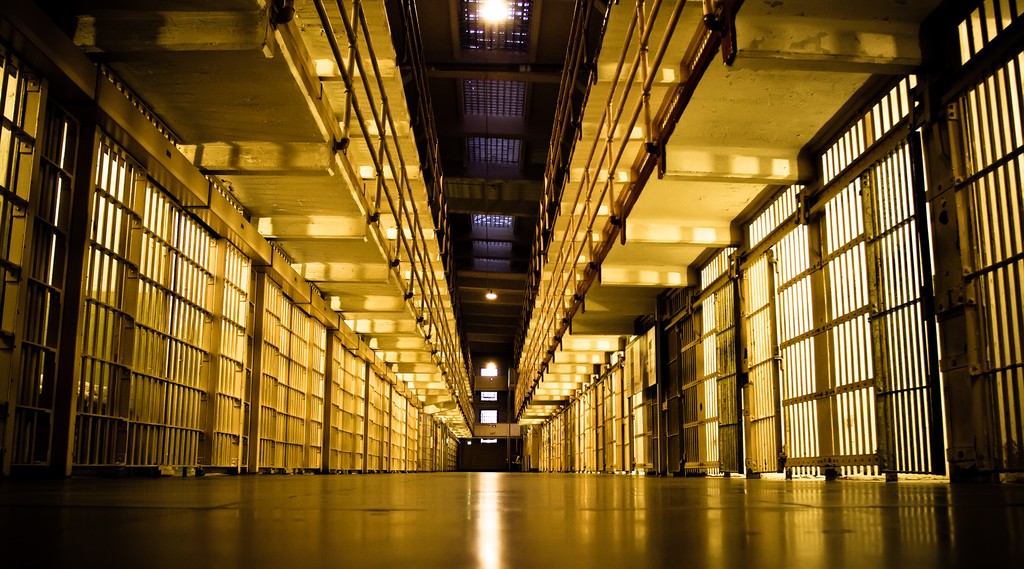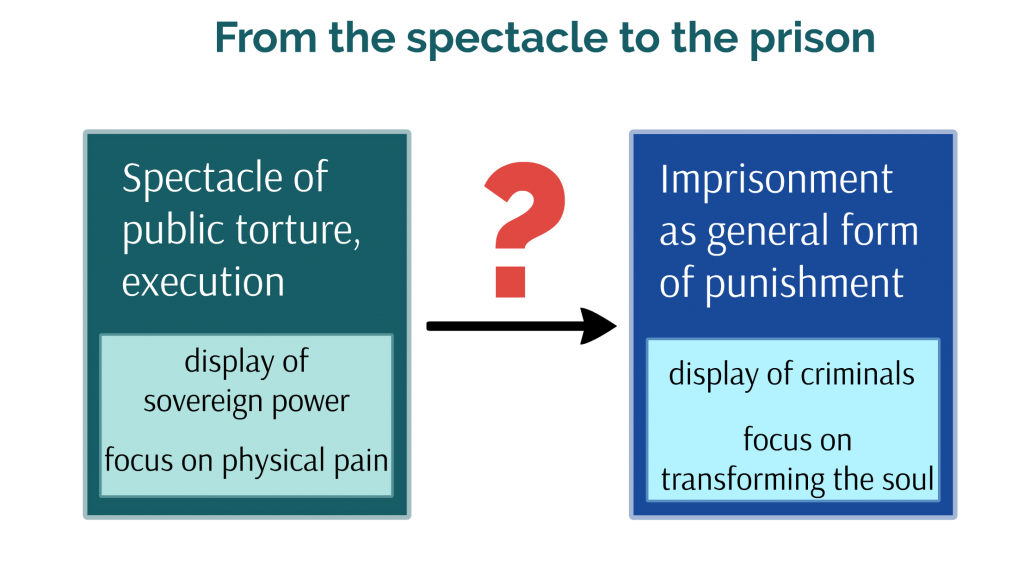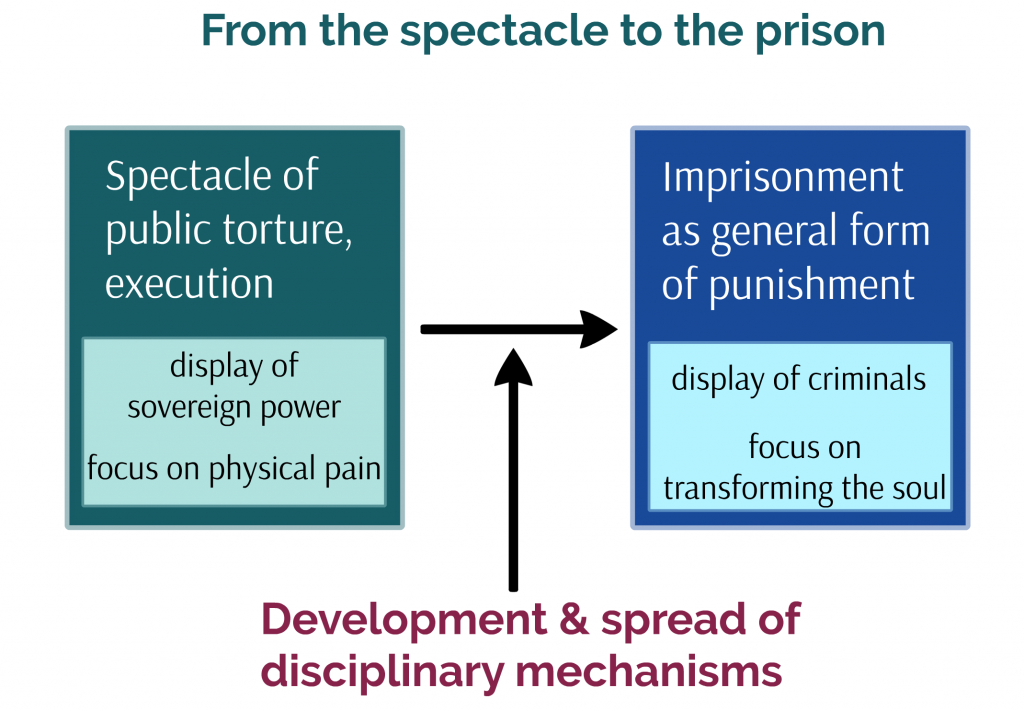
cell block d, Flickr photo shared by Sean Hobson, licensed CC BY 2.0
In Arts One this week we are discussing Foucault’s Discipline and Punish, but just parts 1 and 3. I gave a lecture early on in the week, and realized the next day that there was something I should have done in the lecture: because this text is complex, how the parts fit together may not be clear to people reading it for the first time, and I should have tried to outline that in the lecture.
So I’m going to do so now, here, instead (and add this into the lecture next year! It’s much faster if I say it than writing it all out).
What follows isn’t an outline of the whole text, just an attempt to show how what he’s doing in Part 1 and Part 3 work together.
From the public execution to the prison
The subtitle of the book, in English, is “The Birth of the Prison” (in French it’s Naissance de la prison). And we don’t get much about the prison in parts 1 and 3; it comes in part 4. But part of what he’s doing in the text is talking about how, in Europe, punishment moved from a kind of spectacle of sovereign power, whether in public executions or other public punishments, to the enclosure of people in prisons. “I would like to write the history of [the] prison, with all the political investments of the body that it gathers together in its closed architecture,” Foucault writes at the end of the first chapter.
In the second chapter of Part 1, “The Spectacle of the Scaffold,” Foucault describes the public spectacle of punishment, and in Part 2 he describes what reforms were called for in punishment in France in the latter half of the 18th century (Part 2 was not assigned for us to read). But they didn’t call for what actually happened: most crimes ended up being punished through imprisonment. The reformers though of imprisonment as just one possible punishment among many, and only reserved for certain kinds of crimes (114). However, Foucault notes, “within a short space of time, detention became the essential form of punishment. In the penal code of 1810, between death and fines, it occupies … almost the whole field of possible punishments” (115). He then asks why that should have become the case.
The two stories that open the text, that of the execution of Damiens and the time-table for the prison for young people written up by Faucher, exemplify this shift in types of punishment. And imprisonment is not just a matter of locking people away; it also focuses on the “soul” rather than the body: much more attention is paid to the criminal and his/her “passions, instincts, anomalies, infirmities, maladjustments …” (17). Punishment connected to the prison now considers not just the crimes someone did, but “Where did [they] originate in the author himself? Instinct, unconscious, environment, heredity”? (19). It’s not just a matter of punishing the act, but also the person themselves, and of asking how that person can be transformed: “the sentence that condemns or acquits is not simply a judgement of guilt …; it bears within it an assessment of normality and a technical prescription for a possible normalization” (21). The time-table described by Faucher (6-7) is part of technique of attempting to reform individuals, not just punish acts.
So, again, Foucault’s question is: Why did Europe (and in particular France, which is what he is focusing on here), move from the public spectacle to the normalizing prison?

A screen shot of a new slide I added to the Prezi visuals for my lecture on this text
Disciplinary power
What happened in the meantime was the development of disciplinary methods. Those are what he is describing in Part 3. The partitioning of space, the observation of people to try to make sure they are acting in the most efficient manner, the breaking up of actions so as to manage them in a deep way (like the action of raising a rifle, p. 153), the attempt to get as much use out of elements of time as possible, and more are part of the “docility-utility” that disciplinary mechanisms attempt to enforce on the body. They try to make people more “docile” (compliant, submissive) and at the same time more “useful” (efficient).
The examination–which is a practice that can range from exams in schools to exams by doctors or psychologists, to examinations of prisoners to determine if they are ready for release or parole–is an important disciplinary mechanism that Foucault talks about in the chapter entitled (“The Means of Correct Training”). It combines surveillance with normalization, with judging people against a norm, classifying and ranking them (as discussed in lecture). The examination allows for individuals to be both visible and knowable: they become described in documentation that makes of the individual a “case” that is “described, judged, measured, compared with others … [and also] trained or corrected, classified, normalized, excluded, etc.” (191).
— Did you catch that? Seeing and knowing…our course theme! —
The panopticon is both a building plan for a prison developed by Jeremy Bentham (and a design for some actual prisons) and a conceptual model for how disciplinary power works. It emphasizes the visibility of individuals for the sake of surveilling them, of examining them, and developing knowledge about them (203-204).
It also has the benefit of getting people to conform to norms on their own, to discipline themselves: “He who is subjected to a field of visibility, and who knows it, assumes responsibility for the constraints of power; he makes them play spontaneously upon himself; he inscribes in himself the power relation in which he simultaneously plays both roles; he becomes the principle of his own subjection” (202-203). When you think at any moment you might be being watched, but you can’t be sure if you are (the “unverifiability” of the observation (201)), it’s much more likely that you will discipline yourself to act as you are supposed to: “it is not necessary to use force to constrain the convict to good behaviour, the madman to calm, the worker to work, the schoolboy to application, the patient to the observation of the regulations” (202).
From disciplinary mechanisms to the prison
These disciplinary mechanisms and the panoptic model developed in many institutions and practices: in the military, schools, hospitals among other places (138). But what happened was that they were useful, and ended up spreading; Foucault refers to “the gradual extension of the mechanisms of discipline throughout the seventeenth and eighteenth centuries, their spread throughout the whole social body, the formation of what might be called in general the disciplinary society” (209).
Soon they were used by the police and the legal system (213-215). And they, and the panoptic model of the prison, became embedded in punishment.
All the great movements of extension that characterize modern penality–the problematization of the criminal behind his crime, the concern with a punishment that is a correction, a therapy, a normalization, the division of the act of judgement between various authorities that are supposed to measure, assess, diagnose, cure, transform individuals–all this betrays the penetration of the disciplinary examination …” (227).
Foucault ends part 3 with a question that, hopefully, now might make more sense: “Is it surprising that prisons resemble factories, schools, barracks, hospitals, which all resemble prisons”? (228). Because according to him, the prison developed in large part through the spread of disciplinary mechanisms that were used in these other institutions.
And Foucault, as noted in my lecture, leaves it up to us whether we want to question, and possibly resist, the disciplinary and panoptic aspects of all of them.
